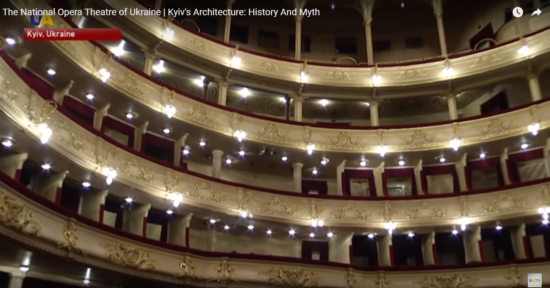The history of the National Opera Theater of Ukraine in Kyiv goes back a 150 years.
After the first theater burned down in 1896, it was replaced with the structure we see today.
At first, Kyiv’s residents did not like the opera theater building. Its appearance was criticized, because people said it resembled a turtle, but the public’s opinion changed after the opening of the first season.
In its heyday, the interior of the theater offered its audience a sophisticated atmosphere. It was abundantly adorned with decorations of velvet, bronze, crystal and gilt elements. Chandeliers and spectator chairs were commissioned from Vienna, Austria. Boxes and balconies were accented with stucco molding. When it was first created, It was one of the most spacious buildings in Kyiv, with the capacity to host 1700 spectators.
Boxes were placed for the nobility; the parterre was intended for the more general public. The upper tiers were occupied by poor spectators, at that time mostly students. It was outfitted with the latest technology and fully hooked up to electricity. Unusual technologies were used to enhance the building’s acoustics. For example, broken glass was placed under the stage. Everyone appreciated the acoustics of the theater, especially the singers.
At the end of 1911, a fatal event took place in the theater, which historians believe changed the course of world history. While attending a performance, the prime minister of the Russian Empire, Pyotr Stolypin, was shot by another spectator. Stolypin died a few days later. He was buried in the Kyiv Pechersk Lavra church. Historians say that if he had remained alive, Russia would be different than it is today. It would be more modern, and social conflicts and tensions would be lower.
In 1917, Volodymyr Vynnychenko read the first legal act on the stage of the theater, issued by the Ukrainian parliament, concerning the autonomy of the Ukrainian People’s Republic. Historians say that Ukrainian statehood was born here. Vynnychenko was a Ukrainian statesman, political activist, writer, playwright and an artist. He served as the first Prime Minister of Ukraine.
The theater even miraculously survived the Second World War, despite the fact that it was hit by an air bomb in 1943.
Today, the National Opera of Ukraine performs at the theater, along with the Ukrainian ballet. People from all over the world are still eager for a seat and a chance to witness a performance in the magnificent building.
The building is today a landmark in Kyiv.













